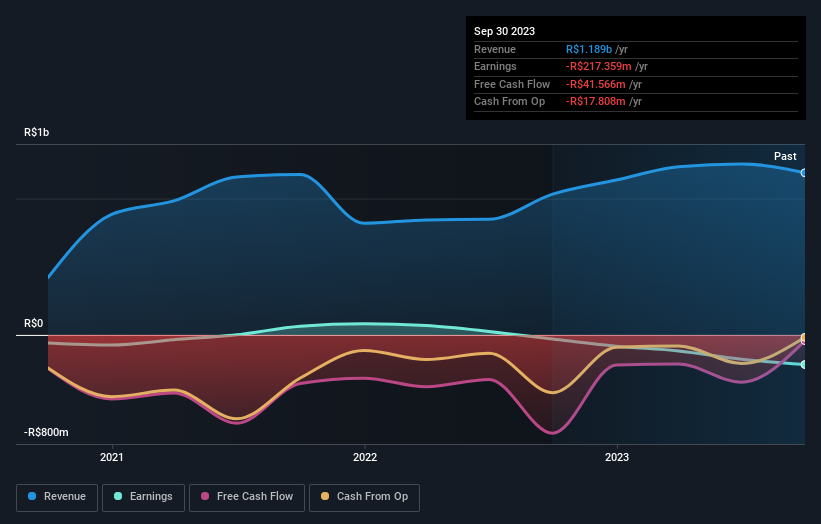- Brazil
- /
- Consumer Durables
- /
- BOVESPA:GFSA3
Institutional investors are Gafisa S.A.'s (BVMF:GFSA3) biggest bettors and were rewarded after last week's R$138m market cap gain

Key Insights
- Significantly high institutional ownership implies Gafisa's stock price is sensitive to their trading actions
- A total of 4 investors have a majority stake in the company with 54% ownership
- 11% of Gafisa is held by insiders
A look at the shareholders of Gafisa S.A. (BVMF:GFSA3) can tell us which group is most powerful. And the group that holds the biggest piece of the pie are institutions with 49% ownership. That is, the group stands to benefit the most if the stock rises (or lose the most if there is a downturn).
Last week’s 17% gain means that institutional investors were on the positive end of the spectrum even as the company has shown strong longer-term trends. One-year return to shareholders is currently 31% and last week’s gain was the icing on the cake.
In the chart below, we zoom in on the different ownership groups of Gafisa.
View our latest analysis for Gafisa

What Does The Institutional Ownership Tell Us About Gafisa?
Institutions typically measure themselves against a benchmark when reporting to their own investors, so they often become more enthusiastic about a stock once it's included in a major index. We would expect most companies to have some institutions on the register, especially if they are growing.
We can see that Gafisa does have institutional investors; and they hold a good portion of the company's stock. This implies the analysts working for those institutions have looked at the stock and they like it. But just like anyone else, they could be wrong. If multiple institutions change their view on a stock at the same time, you could see the share price drop fast. It's therefore worth looking at Gafisa's earnings history below. Of course, the future is what really matters.

We note that hedge funds don't have a meaningful investment in Gafisa. MAM Asset Management Gestora de Recursos Ltda. is currently the largest shareholder, with 19% of shares outstanding. For context, the second largest shareholder holds about 14% of the shares outstanding, followed by an ownership of 11% by the third-largest shareholder.
To make our study more interesting, we found that the top 4 shareholders control more than half of the company which implies that this group has considerable sway over the company's decision-making.
While it makes sense to study institutional ownership data for a company, it also makes sense to study analyst sentiments to know which way the wind is blowing. There is some analyst coverage of the stock, but it could still become more well known, with time.
Insider Ownership Of Gafisa
The definition of company insiders can be subjective and does vary between jurisdictions. Our data reflects individual insiders, capturing board members at the very least. Management ultimately answers to the board. However, it is not uncommon for managers to be executive board members, especially if they are a founder or the CEO.
I generally consider insider ownership to be a good thing. However, on some occasions it makes it more difficult for other shareholders to hold the board accountable for decisions.
Our information suggests that insiders maintain a significant holding in Gafisa S.A.. Insiders have a R$104m stake in this R$942m business. We would say this shows alignment with shareholders, but it is worth noting that the company is still quite small; some insiders may have founded the business. You can click here to see if those insiders have been buying or selling.
General Public Ownership
With a 26% ownership, the general public, mostly comprising of individual investors, have some degree of sway over Gafisa. While this size of ownership may not be enough to sway a policy decision in their favour, they can still make a collective impact on company policies.
Private Company Ownership
We can see that Private Companies own 14%, of the shares on issue. Private companies may be related parties. Sometimes insiders have an interest in a public company through a holding in a private company, rather than in their own capacity as an individual. While it's hard to draw any broad stroke conclusions, it is worth noting as an area for further research.
Next Steps:
It's always worth thinking about the different groups who own shares in a company. But to understand Gafisa better, we need to consider many other factors. Case in point: We've spotted 3 warning signs for Gafisa you should be aware of, and 2 of them are a bit unpleasant.
If you would prefer discover what analysts are predicting in terms of future growth, do not miss this free report on analyst forecasts.
NB: Figures in this article are calculated using data from the last twelve months, which refer to the 12-month period ending on the last date of the month the financial statement is dated. This may not be consistent with full year annual report figures.
New: Manage All Your Stock Portfolios in One Place
We've created the ultimate portfolio companion for stock investors, and it's free.
• Connect an unlimited number of Portfolios and see your total in one currency
• Be alerted to new Warning Signs or Risks via email or mobile
• Track the Fair Value of your stocks
Have feedback on this article? Concerned about the content? Get in touch with us directly. Alternatively, email editorial-team (at) simplywallst.com.
This article by Simply Wall St is general in nature. We provide commentary based on historical data and analyst forecasts only using an unbiased methodology and our articles are not intended to be financial advice. It does not constitute a recommendation to buy or sell any stock, and does not take account of your objectives, or your financial situation. We aim to bring you long-term focused analysis driven by fundamental data. Note that our analysis may not factor in the latest price-sensitive company announcements or qualitative material. Simply Wall St has no position in any stocks mentioned.
About BOVESPA:GFSA3
Gafisa
Operates as a development and construction company under the Gafisa brand name in Brazil.
Excellent balance sheet and good value.


